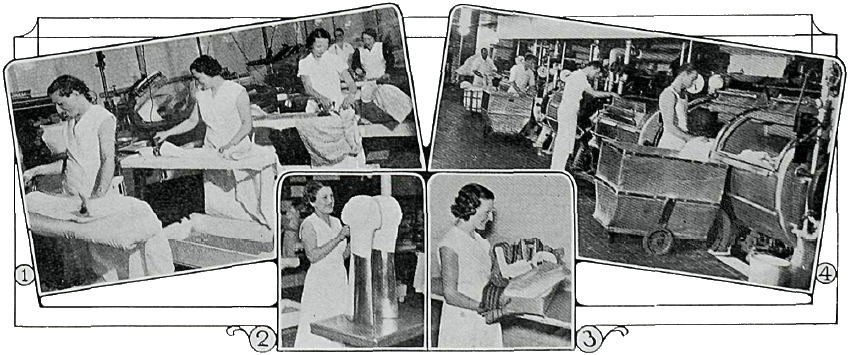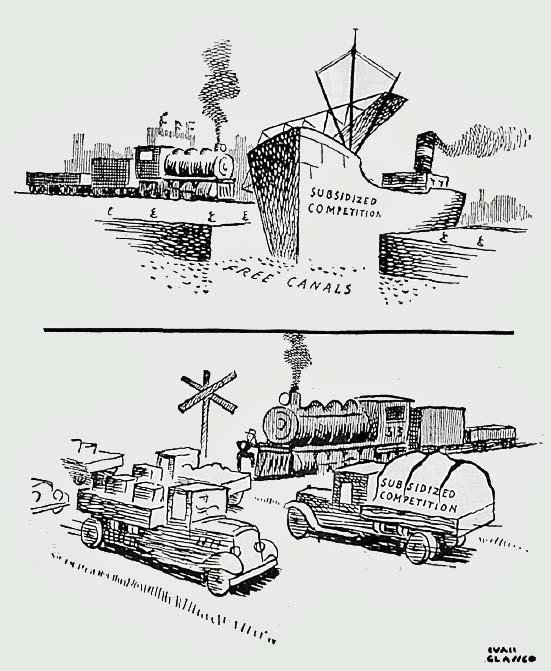
|
NUMBER 20
|
WINDSOR STATION - MONTREAL
|
SEPTEMBER 1st, 1937
|
of Service and Efficiency

An average person entering the bedrooms or dining rooms of a hotel, the dining or sleeping car on a train, or the stateroom on a steamship, is inclined to take for granted the spotless linen which he sees, and naturally expects, without a thought to the work and organization which is responsible.
The Company operates nine laundries in connection with hotels across the continent, with an investment of approximately $700,000 in high-class machinery and equipment, employing on an average 285 people the year around. These laundries handle the work from our hotels, sleeping and dining cars, steamships, and also serve the guests. Practically all of the latter work is done on an eight-hour service which means that a guest arriving in the morning can have clothing returned clean and fresh by five o'clock in the afternoon.
During the year 1936, 23,300,000 pieces of linen of all classes were laundered by our hotel laundries for these various departments. When it is considered that every piece has to be checked and accounted for, and even the simplest items are handled at least ten times, some idea of the work involved can be arrived at. It speaks well for working conditions when it is stated that the labor turnover is very small indeed. Taking one of our laundries, for instance, we have 26 employees with a total of 328 years' service, ranging from 30 years down to five, or an individual average of nearly 13 years each.
Many Improvements
Great changes and improvements have taken place in methods and machinery even during the past twenty-five years and it is a far cry from the old wooden washing machines to those of today, constructed of stainless monel metal, costing nearly $4,000 each, capable of washing 250 to 300 pounds of work in one load, and flat-work ironers which can dry and iron sheets at the rate of more than 500 an hour.
A visit to the laundry in the Royal York Hotel, Toronto, would be well worthwhile and an education to anyone not familiar with laundry operations. This well known laundry, which handles the work for the hotel itself, the guests and the staff, the linen for the district bunk houses, and much of the washing required for the sleeping, dining, and parlor cars from the Winnipeg-Toronto-Montreal line and from the Toronto-Windsor-Detroit route, as well as the laundry work during the summer for the French River Chalet Bungalow Camp, is the largest and most up-to-date hotel laundry in the British Empire. It is as well the largest institutional laundry in Canada.
Tremendous Capacity
During 1936, 7,677,823 pieces were laundered at this laundry, or an average number of 24,608 pieces per working day. Of this total of just over seven and one-half million pieces, the Royal York hotel, its staff and its guests, claimed no less than 5,866,230 for a working day average of approximately 15,000.
All the extensive batteries of machines, which are each individually driven and fitted with every known safety device, are located in one large room in which the air is oil washed. This makes the laundry very compact for the volume of work to be handled and the special air conditioning used makes it the healthiest of spots for the 55 or so workers who have mostly been there since the laundry opened early in May, 1929. In fact, during the recent flu epidemic in Toronto the Royal York hotel laundry was one of the healthiest spots to work in. The white clad uniformed girls with their cheerful and good looks, as if they had been picked for a beauty contest, give this pleasing spot an added attraction and take the blue out of wash days. The floor is covered with red tiles, with the walls covered with white tiles.
The laundry is the last word in construction and safety and accidents of any kind are almost unknown. With the exception of three new coat presses which are air driven, all the countless machines are motor driven. The presses driven by air have indeed proved to be most efficient from an economical and volume standpoint. There can be no breakdown in motor power for the other machines as they are all equipped with auxiliary driving motors operated through remote control from the panel control board.
It is impossible to discuss in detail the individual number of machines, as there are machines for everything, a machine even for putting the wing on the dress collars, a machine for ironing the dress shirt front, machines for collars and cuffs, a machine for the caps of the chef and his assistants, and machines for drying, stretching, and mending socks and stockings. There are four large washing machines for hotel flat work which can handle eight three-hundred pound loads per day each. There are too, four smaller washing machines for individual guest and staff work, curtains, fancy bedspreads, and similar articles. There is one special washing machine for fine woollen work. There are four large 48 inch extractors for flat work, and two 30 inch extractors for the guests' work. Then there are two large shake-out machines which separate the clothes and enable quick handling.
There are three thermo-vento, 40 x 94 inch, drying tumblers for bath towels and mats equipped with thermostat control. These machines are fully automatic and ring a bell when towels and mats are finished. Curtains are taken from the extractor to a three-section curtain dryer which stretches them to their original size. This dryer is equipped with a series of steam coils and a fan. There is also a steam press for such items as velours and velvets.
Then there are three monster 8 roll flat work ironers equipped with vacuum features which take care of the moisture absorbed by the padding from the wet goods passing through the machine. There are also enclosed glass canopies over these machines that take care of the moisture coming from the goods passing over the ironing surfaces. Approximately 500 sheets can be passed through each flat work ironer in one hour. In fact the Royal York hotel laundry has every modern machine to delight both the engineering expert and the laundry worker.
Thorough Checking
There is a very thorough system of sorting through the pieces as they are sent out finished. The guests' washing is all marked, if this has not already been done, with the exception of handkerchiefs, which are not marked but are kept in individual nets. There are special rooms for the reception of guests' laundry, hotel, and outside work, and there are special rooms for the reception, when finished, by the housekeeper, of the hotel work. Indeed the checking system in vogue is so thorough that the very occasional mislaid article is generally easily discovered.
When the individual guest's laundry is finished and checked, the larger articles are placed in an attractive paper envelope with a printed list on it of the current attractions the hotel has to offer. All the articles are then carefully placed in a tissue paper lined box and returned to the guest's room.
Divided into the following seven sections, sorting, washing, flat-ironing, starching, pressing, ironing, and checking, the Royal York laundry, which is situated in the basement of the hotel, is under the charge of J.W. Armstrong, the efficient plant superintendent, who has had twenty years' experience in the laundry industry. Mr. Armstrong, who worked for 10 years with commercial laundries before joining the Canadian Pacific hotel system, came to the Royal York in March, 1934, after 2 1/2 years at the Hotel Saskatchewan laundry and 4 1/2 years at the Palliser hotel laundry. The very capable and courteous clerk of the laundry is Mrs. D.E. Butt.

This Staff Bulletin article is copyright 1937 by Canadian Pacific Railway Limited
 and is reprinted here with their permission.
All photographs, logos, and trademarks are the property of the Canadian Pacific Railway Company.
and is reprinted here with their permission.
All photographs, logos, and trademarks are the property of the Canadian Pacific Railway Company.